 | |
                 
|

|


HUNTING / GATHERING
At contact, the Aboriginal economy was based on a stable, considered management of the environment and an effective organisation of labour. Males and females made different but complementary economic contributions. Women were primarily the gatherers of vegetables, roots, herbs, fruits and nuts, eggs and honey, and small land animals such as Snakes, Goannas. Men were the hunters of large land animals and birds and also co-operated to organise large-scale hunting drives to catch Emu's and Kangaroos.The collection and preparation of this wide variety of bush food required the development of an efficient, multifunctional technology, considerable practical skills, and its seasonal changes. Some plant foods were easy to collect but required complex preparation before they could be eaten.

SHELTER
A combination of nomadic lifestyle and the regions sunny climate meant that there was no need to build substantial dwellings. The shelter was relatively used in permanent camps and was consisting in a frame work of saplings covered with a thatch of material locally available.RELIGION / CEREMONY
The Dreaming, the Dreamtime has become a handy phrase used to describe what is in fact a sophisticated and interconnected mosaic of knowledge, beliefs and practises concerning the creativity of Ancestral Beings, and the continuity and values of Aboriginal life.The vibrant ceremonial and religious life of Northern Territory people generated a spectacular array of art forms, including body painting and personal ornamentation, ground sculpture, bark painting, wood carving, and rock painting and engraving. Artistic creativity and innovation were informed by religious belief. Designs and motifs embodied multiple sets of meanings about group ownership of lands and relationships to particular Ancestral Beings. These expressions along with the rich oral traditions, elaborate song and dance styles and personal performance of them, were all regarded as manifestations of the original ancestral creative power. Each generation accepted responsibility for passing on the economic, social and religious knowledge, beliefs and actions that ensured the reproduction of Aboriginal societies and cultures.
Before the dawn of the present age was "the Dreaming", or the Alchera of the Aranda, a time when the ancestors of the Aborigenes wandered over a featureless land. These ancestors were unlike people of today ; they possessed special powers and were so intimately associated with certain animals and plants that an ancestor of the kangaroo totem "many sometimes be spoken of either as a man-kangaroo or as a kangaroo-man. As the ancestors journeyed over the land, their actions gave if form, created the natural features such as rivers and ranges. The land they shaped is today occupied by their descendants.
During their travels the dreamtime ancestors carried one or more sacred tjurunga, each "intimately associated with the idea of a spirit part of some individual". Many tjurunga were buried, each burial site marked by a natural object such as a rock or a tree.
Other places of significance are where ancestors entered the earth, at which time they died, but their spirits remained within the buried tjurunga. These places were also marked by natural objects.
There are thus at the present day, dotted about all over the Arrernte country, a very large number of places associated with these Alcheringa spirits, one group of whom will be Kangaroo, another Emu, another Hakea plant, and so on. When a woman conceives it simply means that one of these spirits has gone inside her, and knowing where she first became aware that she was pregnant, the child, when born, is regarded as the reincarnation of one of the spirit ancestors associated with that spot, and therefore it belongs to that particular totemic group.
TRADE / ART / MUSIC
Aboriginal group exchanged natural resources, such as ochres, and tools, such as stone axes and boomerangs, thus creating extensive trading networks. Goods travelled hundreds of kilometres from their original source.For example, boomerangs made in Central Australians would find their way to Arhem Land and the surrounding islands. Didgeridoos from Arhem Land would find their way down to Central Australia. Pearl shells from the Kimberley were traded through Central Australia down into South Australia.
Trading networks were frequently incorporated into formal exchange systems. Large, gatherings of people came together for "exchange ceremonies" where regional specialities were traded. Ritual paraphernalia, sacred ceremonial objects , song verses and dance styles were also passed on from one group to the next at such gatherings.
Arrernte Index
CULTURE | DIDGERIDOO | GALLERY | EMAIL US | HOME PAGE |